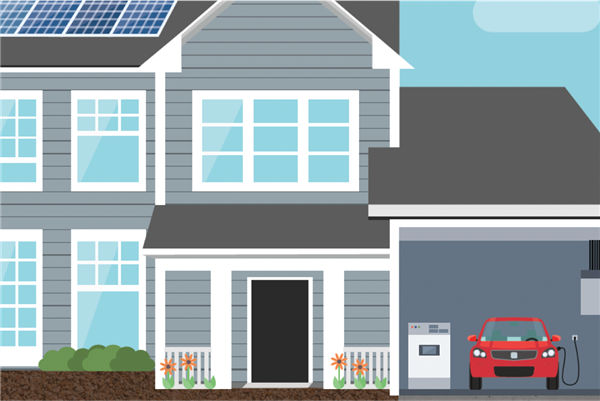Clean Energy Options

Renewable energy, often referred to as clean energy, uses sources that are continually replenished by nature. Solar electricity or photovoltaic (PV) technology converts sunlight into electricity for your home. When combined with battery storage and electric vehicles, solar electric systems can go a long way to enhance your home’s energy independence and resilience, lower utility bills, and reduce your carbon footprint.
SOLAR PV SYSTEMS
Solar PV panels are composed of cells that are made from silicon and other materials that transform sunlight directly into electricity. Over the last decade the cost of installing a solar electric system has declined sharply, making solar PV systems more affordable than ever to install. With new cost-effective solar PV systems, homeowners can become part of the solution by using clean, renewable energy sources while saving on electricity costs. If installing a solar electric system on your home is not feasible because of excessive shade or other issues, consider switching to your utility’s 100 percent renewable rate.
Here’s a Tip: Do your energy efficiency upgrades first – you’ll reduce your demand for energy, which may mean you need to install fewer solar panels, lowering your upfront costs while reducing your ongoing energy costs.
NET ENERGY METERING (NEM)
NEM allows customers who generate their own energy ("customer-generators") to serve their energy needs directly onsite and to receive a financial credit on their electric bills for any surplus energy fed back to their utility. Under net metering, energy that your solar PV system produces during the day that you don’t use is applied as a credit to your account. On a cloudy or rainy day or at night when your panels aren’t producing enough energy, the utility grid will provide energy to your home, and count that energy used against the credits you’ve banked over time.
BATTERY STORAGE
Batteries can supply backup power during power outages and help you manage your electricity use to save money. The vast majority of energy storage systems installed in the US are paired with solar. To save money during normal grid operation, charge your battery with solar during the day when rates are low and power your home with your battery instead of the grid during peak periods when electricity rates are highest. A solar PV system tied to the grid without battery storage and islanding capabilities is required to automatically shut down during a power outage to protect line workers. If you are installing a battery storage system for emergency backup, your solar PV plus battery system will have a special type of inverter with islanding capability. During an outage, your system will automatically “island” or disconnect from the grid keeping your power on, providing a source of electricity to keep important devices and appliances running until the grid comes back online. During the day your solar system will continue to feed into and charge your battery. Under favorable solar conditions with limited home electricity use, pairing solar with a battery storage system can help your devices stay powered for multiple days.
ELECTRIC VEHICLES (EVs)
Significant improvements in battery technologies and overall EV efficiency have led to an expanding number of EV models with increased driving ranges. The cost of electricity to power an EV is lower than the mileage-equivalent cost of gasoline. Maintenance costs are lower because there are fewer moving parts and no oil changes. Instead of searching for a gas station with the cheapest price, you can conveniently charge at home or at an ever-growing network of EV charging stations and all-electric vehicles have zero tailpipe emissions. An electric engine generates instant torque, which means that electric vehicles provide smooth, responsive acceleration and deceleration. With their immense potential for increasing the country's energy security, economic vitality, and quality of life, EVs will play a key role in the country's transportation future.